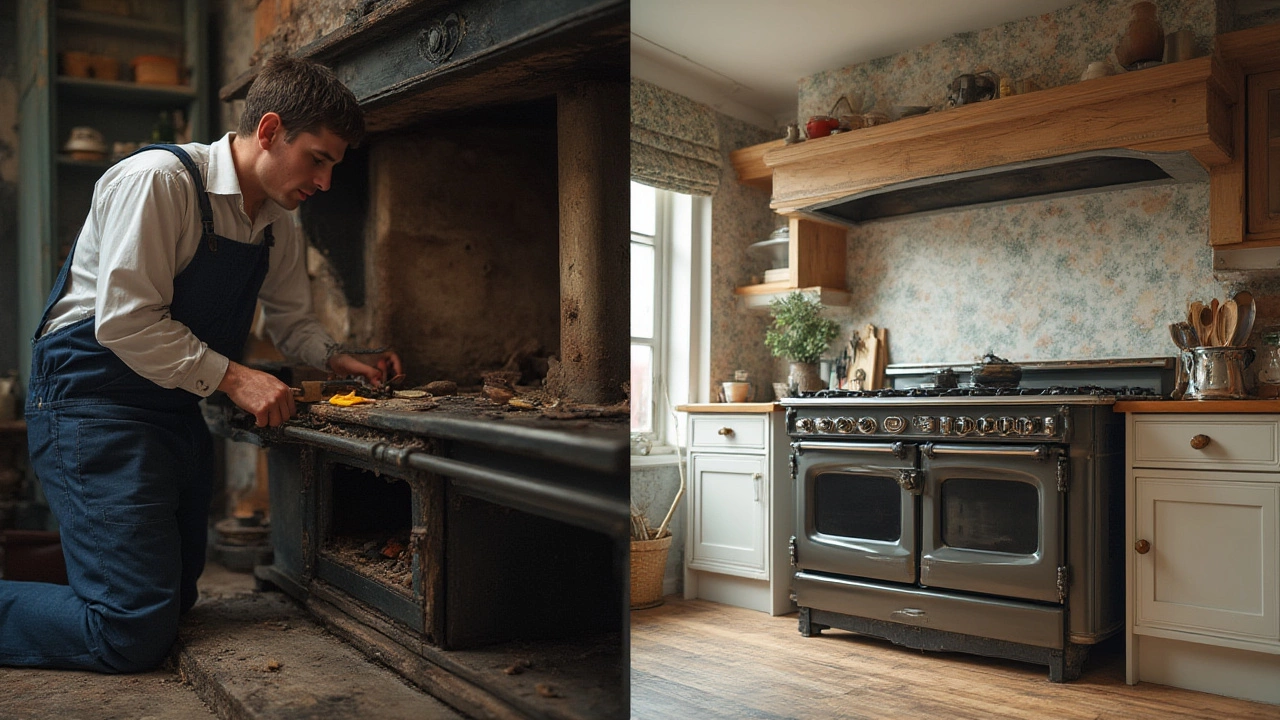You probably don’t think much about your stove—until one day, it takes forever to preheat or one of the burners won’t light at all. If your stove’s pushing 15 years (or older), you’re stuck with a tough decision. Is it worth fixing, or are you just tossing money into an appliance that’s not long for this world? Kitchen upgrades aren’t cheap, but neither are unnecessary repairs, especially in 2025, where costs are rising faster than a boiling kettle.
The Lifespan of Stoves: What to Expect After 15 Years
Most stoves, whether gas or electric, are built to last around 13 to 17 years if treated well. That sweet spot puts a 15-year-old unit right at the edge of its shelf life. Manufacturers like Whirlpool, GE, and Samsung all agree on this range. Your typical electric coil model may stretch toward 20 years, but for stoves with digital controls, touchscreens, or induction cooktops, breakdowns show up earlier due to more delicate parts.
If you’ve babied your stove—regularly cleaning burners and checking connections—you might get lucky and squeeze out a couple more years. But here’s a cold, hard fact: most appliance techs say repair requests spike for stoves after the 10-year mark. And by year 15, major issues aren’t far behind, like failing oven igniters, inconsistent temperature sensors, or cracked glass cooktops. By now, the manufacturer likely isn’t stocking parts, except maybe from third-party sellers (and those prices jump every year).
Still, every kitchen has a story. Some 20-year-old stoves are running just fine, just a little outdated. On the flip side, appliances built in the late 2000s—especially with early digital boards—can develop expensive quirks well before 20 years hits. Take a look at this table showing average stove lifespan based on type and generation:
| Stove Type | Average Lifespan (years) | Common Age-Related Issues |
|---|---|---|
| Electric Coil | 16-20 | Burner failure, oven element burnout |
| Electric Smooth Top | 13-17 | Cracked glass, control board issues |
| Gas Stove | 15-18 | Igniter trouble, burner clogging |
| Induction | 10-15 | Cooktop faults, electronics failure |
So if yours is pushing 15, you’re right at the decision line. Time to look at how repairs stack up against a full-on replacement.
Cost Breakdown: Repairing Versus Replacing Your Old Stove
Let’s talk numbers. Everyone wants to avoid wasting money, but in the appliance world, repairs can turn into a money pit fast. A minor fix—like a new burner, oven element, or a new thermostat—runs about £60-£140 for parts and labor, if you catch a deal. But when you need a new control board, electronic display, or, say, a replacement glass cooktop, you’re easily staring at £200-£300 just for the part. Add labor on top, and those bills climb as quickly as dough in a warm oven.
Now, compare that with the cost of replacing the whole stove. According to a 2025 consumer review, the average price for a new standard electric or gas stove in the UK runs between £290 (basic models) up to £800 (mid-range, reliable brands). Slide-in or smart stoves? Expect to pay north of £1200, especially for induction or dual-fuel options. If you’re leaning toward repair, ask yourself this: is the repair quote more than half the price of a new model? If yes, you’re almost always better off buying new. Appliance insurance providers and big retailers stand by this “50% rule.”
Don’t forget about hidden costs. If you need a part that’s become rare, you might have to wait weeks or hunt down sellers, often for inflated prices. And if your trusted local repairman says, “Honestly, I’d replace it if I were you,” he’s probably not just looking for another job—he knows how quickly issues can multiply in old appliances.
- If your stove has needed frequent repairs over the past two years, those bills add up—don’t get stuck in a cycle of patch-up jobs.
- For basic stoves without digital features, replacement parts are usually easier to find and cheaper. If your old stove runs on obscure tech, it’s usually game over when it breaks.
There’s one more angle. Newer appliances are way more energy efficient. On average, a 15-year-old stove uses about 30-40% more energy than today’s models, according to the UK’s Energy Saving Trust. That means you could save £25-£60 per year on energy bills, not to mention shrinking your carbon footprint.

Common Problems in 15-Year-Old Stoves—and Signs It’s Time to Move On
Some issues are quick, cheap fixes—think replacing a single electric burner or unclogging a gas jet. But some repairs on old stoves are warning signs that your appliance has burned through its best years. Keep an eye out for these big red flags:
- Inconsistent heating: Are your cakes half-baked, or are steaks coming out blackened on one side and raw on the other? It’s usually a dying thermostat or failing elements, both expensive in old stoves. Not a quick fix if it keeps happening.
- Unresponsive controls: Older stoves with digital displays often start to lag, freeze, or flicker by year 13-15. Getting a new control panel isn’t always possible and rarely cheap.
- Frequent tripping of fuses or circuits: Older wiring and worn-out parts put you (and your kitchen) at risk. Don’t mess around with repeated electrical faults.
- Gas fumes or clicking sounds with no ignition: That’s a safety hazard, not just an annoyance. Pilots, igniters, or valves can fail in old gas models, and replacement can be costly.
- Broken doors, warped racks, or cracked glass: Most manufacturers drop support for structural parts once an appliance reaches 10-12 years. Sourcing replacements can cost more than a new stove. Plus, it’s just plain dangerous.
On the flip side, an occasional minor problem isn’t the end of the world—especially if parts are available and the cooktop and oven still heat evenly. But frequent, escalating repairs are a sure sign your trusty old stove is on borrowed time.
Tips for Stretching the Life of Your Stove (and Making Repairs Last)
If you’re not ready to say goodbye, here’s how to squeeze every last meal from your old cooker:
- Keep burners, drip pans, and heating elements clean. Grease buildup causes hot spots and element burnout.
- Check seals around the oven door. A leaky seal means heat escapes, leading to poor baking and wasted energy. Replacement is cheap—about £10-£20 online.
- Inspect burner sockets and connections every six months. Loose or corroded contacts can lead to uneven cooking (and can be fixed for pennies).
- Don’t ignore little hiccups—like ‘hot spots’ on your glass top. These are usually the first sign of failing circuits or elements.
- Unplug the stove before cleaning any electrical parts. Sounds obvious, but it’s a common mistake.
- If you have a gas stove, clean burner holes with a soft brush or compressed air, but avoid using pins or anything sharp that can damage metal.
If you need a minor repair, stick to trusted brands for replacement parts. And if your technician can’t source genuine parts, think twice before settling for cheap knock-offs; performance often suffers, and sometimes even voids house insurance.
Some people swear by universal oven thermostats to fix erratic heating, but they’re not always compatible with every model. Double-check before buying any "universal" part, or you could end up with an even costlier call-back.

Deciding: Should You Repair or Replace Your 15-Year-Old Stove?
This is the big question. If you’ve made it this far, you’re probably weighing numbers against peace of mind. Here’s a quick rule of thumb that appliance techs swear by: if the repair costs more than 50% of a similar new model, replace it. If parts are scarce or discontinued, or if you’re noticing new quirks every few weeks, don’t sink more cash—start shopping. But if it’s a simple fix (like a new heating element or burner that’s still readily available), a repair might buy you another year or two.
If you’re sentimental about your stove—maybe it’s helped bake hundreds of birthday cakes—see if you can keep it alive for small money. Sometimes, a skilled technician can pull off miracles. But with skyrocketing energy prices and stricter home insurance requirements in 2025 (yep, some policies now ask for proof your stove’s been checked in the last 2 years!), a new stove is often the safer long-term play.
Before you decide, call at least two reputable technicians for quotes. Make sure they check for other underlying issues, not just the obvious one. Look for deals at local appliance stores—sometimes they’ll recycle your old unit for free and even include installation in the price. And keep an eye out for government grants or rebates; several UK councils offer discounts when you swap out an inefficient appliance for a modern, low-energy model.
Still stuck? Talk to neighbors or check local online forums. Stoves are one of those things everyone has a story about, and someone nearby has probably dealt with the same situation. In the end, whether you repair or replace, make sure it’s a choice that feels right for your budget, your safety, and your cooking style. Because nothing ruins dinner faster than an oven that just won’t heat up—except maybe the bill for a repair that didn’t fix the real problem.


